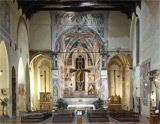Basilica di San Francesco - Ticket Office
A single-nave building designed to reflect the practice typical of the mendicant orders of the day, construction on the Basilica of St Francis started in the second half of the thirteenth century and was completed in the fourteenth. The campanile was added in the sixteenth century. Painstakingly detailed restoration work has almost entirely re-established the original austere simplicity of the grandiose single-nave interior, which is flanked along the right by niches containing fourteenth-century and Renaissance ornamentation and along the left by stark Gothic chapels.While you are inside the basilica, take the time to admire the stained glass by Marcillat, the canvases and frescos by Spinello and other rare and splendid pieces, such as the large crucifix panted by a contemporary of Cimabue, and make sure you go to the last side chapel on the left, to see the funerary monument to the jurist Roselli, which dates to the first half of the fifteenth century. But the basilica owes its fame above all to one of the masterpieces of all Renaissance painting: the Bacci Chapel, with its cycle of frescos of the Legend of the True Cross, painted by Piero della Francesca between 1452 and 1466. The chapel belonged to the wealthy Bacci family of merchants in Arezzo, who commissioned its decoration from the Florentine painter Bicci di Lorenzo in 1447.
But after he had completed work on the chapel’s vaulted ceiling, the two Doctors of the Church in the entrance way and the Last Judgement on the triumphal arch, the maestro died in 1452, the year when Piero della Francesca started working for the Bacci family. It then took him just a few years to complete the most modern frescos conceivable in fifteenth-century Italian painting, with their uniquely measured perspective.
These frescos are set on three levels on the chapel’s side and rear walls, including the most important works: the Dream of Constantine on the rear wall, the Battle at the Milvian Bridge (when Constantine defeated Maxentius) on the right and the Discovery and Verification of the True Cross on the left. Two key scenes are depicted on the rear wall: the Annunciation is an introduction to Christ’s human life on earth, while the Dream of Constantine describes the moment in history when the aspiring sole emperor had a vision of the cross, which then became the victorious battle flag of later Christian sovereigns. The scenes on the side walls are taken from the Old Testament and from the events that followed the Discovery of the True Cross by Constantine’s Mother, the empress Helena.
When designing the layout of the frescos, Piero della Francesca painted scenes located in the open air at the top, court scenes in the middle and battle scenes at the bottom.








